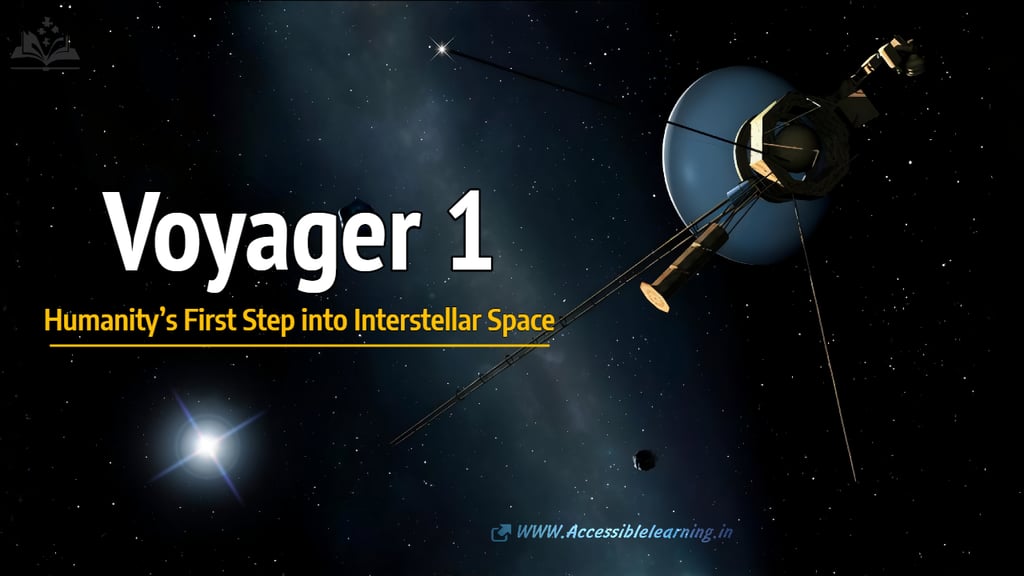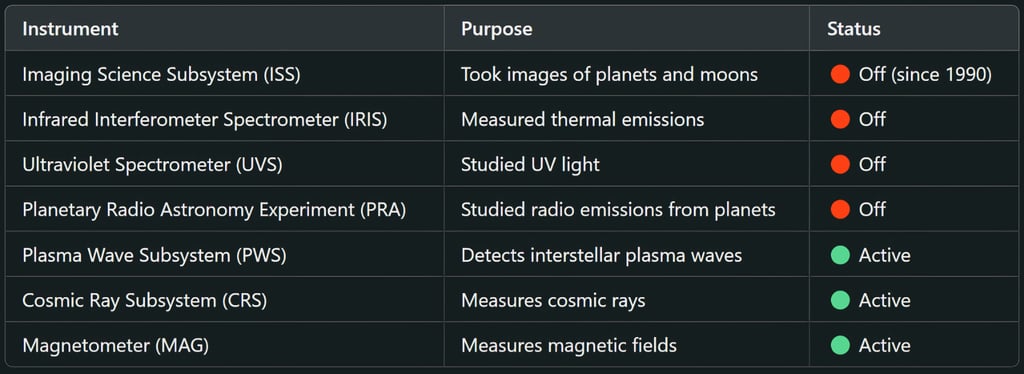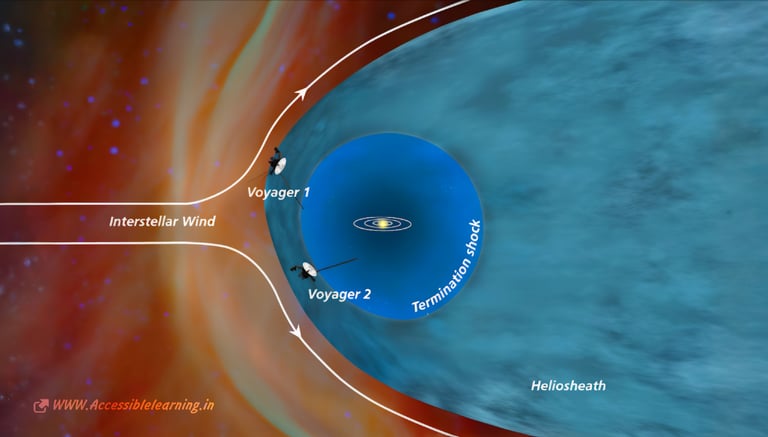
Voyager 1: Humanity’s First Step into Interstellar Space
Voyager 1, NASA’s historic space probe, is the first human-made object to reach interstellar space. Launched in 1977, it has explored Jupiter, Saturn, and beyond, transmitting invaluable data from over 24 billion kilometers away. This article dives deep into its mission, technical details, discoveries, and future journey, making it an essential read for space enthusiasts.
SPACE MISSIONISRO/NASASPACE/TECHEDUCATION/KNOWLEDGE
Sachin K Chaurasiya
3/22/20254 min read


Voyager 1 is one of the most remarkable spacecraft ever built, serving as an interstellar explorer that has been traveling through space for nearly 50 years. Launched by NASA on September 5, 1977, it was originally designed to explore Jupiter and Saturn. However, due to its exceptional durability, Voyager 1 became the first human-made object to leave the solar system and enter interstellar space.
Carrying the Golden Record, a time capsule of Earth's culture, Voyager 1 continues its voyage into the unknown, transmitting invaluable data from billions of miles away. This article delves into its mission, discoveries, current status, and technical details.
Technical Specifications of Voyager 1
Voyager 1 is a highly advanced spacecraft (for its time), designed to operate autonomously in deep space. Here are its key technical details:
Structural Design
Height: 3.7 meters (12 feet)
Weight at launch: 722 kg (1,592 lbs)
Main components:
A high-gain antenna (3.7 meters in diameter) for long-distance communication.
A 10-meter magnetometer boom to measure magnetic fields.
A radioisotope thermoelectric generator (RTG) to supply power.
11 scientific instruments (some of which are still operational).
Power System: RTG (Radioisotope Thermoelectric Generator)
Uses Plutonium-238 as a power source.
It generates 470 watts at launch, but due to radioactive decay, it currently produces less than 250 watts.
Power is expected to drop below usable levels by 2030, leading to a complete shutdown.
Communication System
Uses NASA's Deep Space Network (DSN) for communication.
Signal strength at Voyager 1's current distance is 0.1 billion-billionth of a watt (requires ultra-sensitive receivers).
Current signal travel time: ~22 hours (one-way).
Propulsion System
Uses hydrazine monopropellant thrusters.
Originally designed for short-term trajectory adjustments, but still in use for minor course corrections.


Mission Overview: Journey Through the Solar System
Voyager 1 was part of NASA’s Voyager program, which capitalized on a rare planetary alignment occurring in the late 1970s. This alignment allowed a single spacecraft to use gravity assists to visit multiple planets with minimal fuel usage.
Jupiter Encounter (March 5, 1979)
Voyager 1’s closest approach to Jupiter was at a distance of 349,000 km (217,000 miles). Key discoveries:
Volcanoes on Io: First active volcanoes detected beyond Earth.
Europa’s Icy Crust: Indications of an Underground Ocean.
Jupiter’s Magnetosphere: Measured intense radiation and strong magnetic fields.
Saturn Encounter (November 12, 1980)
Voyager 1’s closest approach to Saturn was 124,000 km (77,000 miles). Key findings:
Titan’s Atmosphere: Found a thick nitrogen-rich atmosphere, leading to future missions like Cassini-Huygens.
Saturn’s Rings: Discovered intricate ring structures with radial "spokes."
After Saturn, Voyager 1 was sent on a trajectory out of the solar system, unlike Voyager 2, which continued to Uranus and Neptune.
Entering Interstellar Space: Beyond the Solar System
Voyager 1's journey beyond the planets continued as it approached the edge of the heliosphere—the boundary where the Sun’s influence fades.
The Heliosphere & Heliosheath
The heliosphere is a bubble of charged particles from the Sun.
The heliosheath is a turbulent region where the solar wind slows down due to interstellar particles.
Crossing the Heliopause (August 25, 2012)
Voyager 1 became the first spacecraft to enter interstellar space.
Scientists confirmed this by detecting a sharp increase in cosmic rays and a drop in solar particles.
The Plasma Wave Subsystem (PWS) detected oscillations in interstellar plasma, confirming its exit from the heliosphere.
Current Status & Future of Voyager 1
Voyager 1 is still transmitting valuable data, but its power supply is dwindling.
Current Distance from Earth
As of 2025, Voyager 1 is about 24 billion km (15 billion miles) from Earth.
Moving at 17 km/s (38,000 mph).
Communication Challenges
It takes 22.5 hours for a signal to reach Earth.
The Deep Space Network (DSN) struggles to detect faint signals.
Remaining Power & Expected Shutdown
Engineers have been shutting down non-essential systems to conserve power.
The last instruments may turn off by 2030–2035.


The Golden Record: Earth’s Message to Aliens
Voyager 1 carries the Golden Record, a 12-inch gold-plated copper disc, designed to last for billions of years. It contains:
🗣️ Greetings in 55 languages: Including English, Mandarin, and ancient Sumerian.
🎵 Music from multiple cultures: Beethoven, Chuck Berry, Indian classical, and more.
📷 Images of Earth: Nature, cities, animals, and scientific achievements.
Even if Voyager 1 is never found by another civilization, it remains a testament to humanity’s curiosity and ambition.
What Lies Ahead?
Voyager 1 is heading toward the constellation Ophiuchus.
In 40,000 years, it will pass within 1.6 light-years of the star Gliese 445.
Even after its instruments fail, Voyager 1 will continue drifting through the Milky Way for millions of years.
Why Voyager 1 is One of the Greatest Space Missions
First spacecraft to reach interstellar space.
Longest-operating space probe in history.
Expanded our knowledge of the outer solar system.
Carries Earth’s message to potential extraterrestrials.
Voyager 1 is a beacon of human achievement, proving that even a small spacecraft launched in 1977 can inspire generations and push the boundaries of exploration.
Subscribe To Our Newsletter
All © Copyright reserved by Accessible-Learning Hub
| Terms & Conditions
Knowledge is power. Learn with Us. 📚


